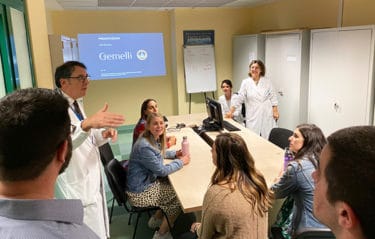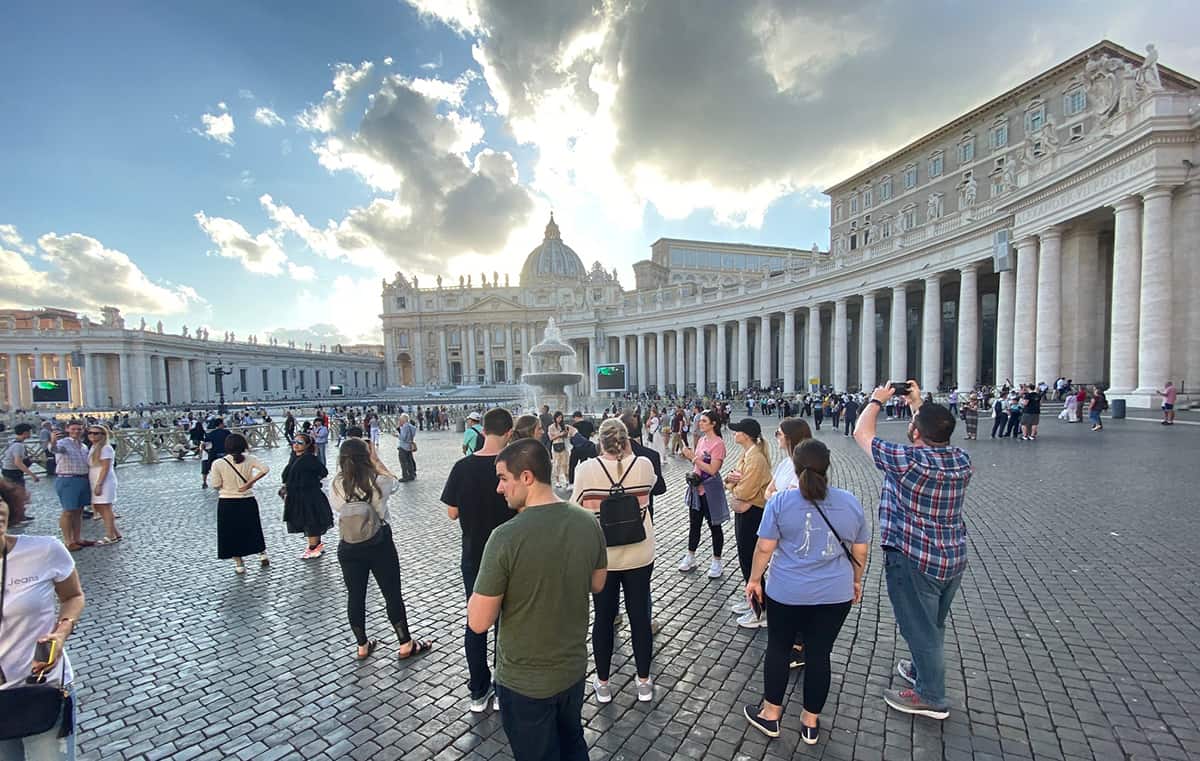New Program Takes Fourth-Year Pharmacy Students to Rome
| In October, UAMS College of Pharmacy students learned new things about pharmacy practice in one of the world’s oldest cities, Rome.
In their fourth year, pharmacy students are required to rotate in ten, one-month blocks through different specialties or clinical settings to gain education and experience about pharmacy practice. On Sept. 30, 10 fourth-year pharmacy students arrived in Rome for a month-long rotation.
The opportunity was born out of a 2018 vacation trip to Rome by Seth Heldenbrand, Pharm.D., the college’s associate dean of Experiential Education.

College of Pharmacy talk to faculty at the Agostino Gemelli University Policlinico, a large teaching hospital in Rome. Each student also was required to approach three different pharmacies and learn about how pharmacy practice was done in each.
Heldenbrand was eating lunch in a restaurant near the Vatican. It was noon, early for lunch by Italian standards so the restaurant was mostly empty. Heldenbrand noticed another diner was wearing a University of Arkansas (UA) shirt. Curious, Heldenbrand asked him about his attire, and the man explained he was the information technology director for the University of Arkansas Rome Center.
Heldenbrand said he hadn’t been aware that the UA system had a presence there. He took a tour of the center, which the University of Arkansas has maintained and shared with some other universities and colleges for 30 years, chiefly for the education of architecture and design students. The center’s director, Francesco Bedeschi, was friendly and very open to the idea of including pharmacy students, Heldenbrand said. Soon, conversations were under way and the UA Hogs Abroad office stepped in to assist in developing a curriculum and budget.
“Before I knew it, we had 10 College of Pharmacy students who wanted to go,” Heldenbrand said.
During the October rotation, students visited the oldest continually operating pharmacy in the world as well as the oldest college of pharmacy in the world. They toured the Agostino Gemelli University Policlinico, a large teaching hospital in Rome, and each student was required to approach three different pharmacies and learn about how pharmacy practice was done in each.
Heldenbrand said pharmacy in Italy is a five-year program started right out of high school. After five years, a student can own or work in a pharmacy. If they opt to work in a hospital pharmacy, it’s a four-year residency before they can fully practice. New pharmacists also do hospital residencies to pursue career tracks in administration, pathology, microbiology and quality control operations.
“My interest in pharmacy is in academia, in teaching” fourth-year pharmacy student Brent Curry said by phone from Rome. “I’d like to teach in the future. I loved comparing their pharmacy college curriculum and really just seeing what I think are our strengths, too.”
Curry said that in the last two of the five years of their training, Italian pharmacy students focus on what kind of pharmacist they want to become. If they want to become a health care administrator, they take elective courses that prepare them for that. Or, if they want to be a nutritional pharmacist then they take courses on nutrition.
“We could benefit from more specialized electives, too,” Curry said.

The students taking part in the Rome rotation stop for a photo outside the Pantheon along with Associate Dean Seth Heldenbrand, Pharm.D., center.
He said it was helpful to have architectural and design students with them on some outings as they toured the Vatican and other sites. An art historian accompanied them on a tour of the oldest pharmacy college and was able to explain some of the art they saw depicting the early history of pharmacy and medicine.
“At the oldest college of medicine near Milan, the professors donated their bodies to science and the students hundreds of years ago learned about anatomy from those bodies,” Heldenbrand said. “All their organs are in jars in formaldehyde. It’s called the Room of Professors. It’s literally a room of old professors.”
Heldenbrand said he’d like to repeat the rotation next year and eventually make it an interprofessional experience that includes students from other UAMS colleges.
“The Rome Center faculty members were amazing at taking something from nothing to create a valuable experience for the students,” he said. “This year’s curriculum was about 75% cultural immersion and 25% pharmacy practice. The Rome Center helped me make the academic contacts I need to grow the program further to a 50/50 curriculum.”
Curry said the rotation has exposed him to different approaches to pharmacy practice and deepened his knowledge of the profession’s history. The students return on Nov. 2.
“It’s starting to feel comfortable being in Rome, which is strange,” he joked. “I think I have to come back to get my degree, though.”
